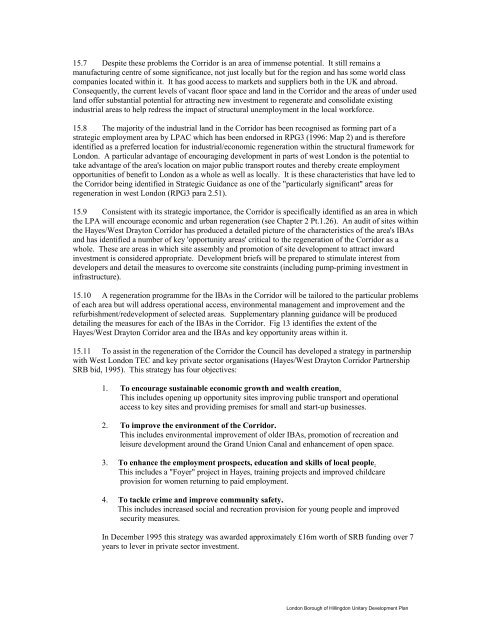HILLINGDON UNITARY DEVELOPMENT PLAN - London Borough ...
HILLINGDON UNITARY DEVELOPMENT PLAN - London Borough ...
HILLINGDON UNITARY DEVELOPMENT PLAN - London Borough ...
You also want an ePaper? Increase the reach of your titles
YUMPU automatically turns print PDFs into web optimized ePapers that Google loves.
15.7 Despite these problems the Corridor is an area of immense potential. It still remains a<br />
manufacturing centre of some significance, not just locally but for the region and has some world class<br />
companies located within it. It has good access to markets and suppliers both in the UK and abroad.<br />
Consequently, the current levels of vacant floor space and land in the Corridor and the areas of under used<br />
land offer substantial potential for attracting new investment to regenerate and consolidate existing<br />
industrial areas to help redress the impact of structural unemployment in the local workforce.<br />
15.8 The majority of the industrial land in the Corridor has been recognised as forming part of a<br />
strategic employment area by LPAC which has been endorsed in RPG3 (1996: Map 2) and is therefore<br />
identified as a preferred location for industrial/economic regeneration within the structural framework for<br />
<strong>London</strong>. A particular advantage of encouraging development in parts of west <strong>London</strong> is the potential to<br />
take advantage of the area's location on major public transport routes and thereby create employment<br />
opportunities of benefit to <strong>London</strong> as a whole as well as locally. It is these characteristics that have led to<br />
the Corridor being identified in Strategic Guidance as one of the "particularly significant" areas for<br />
regeneration in west <strong>London</strong> (RPG3 para 2.51).<br />
15.9 Consistent with its strategic importance, the Corridor is specifically identified as an area in which<br />
the LPA will encourage economic and urban regeneration (see Chapter 2 Pt.1.26). An audit of sites within<br />
the Hayes/West Drayton Corridor has produced a detailed picture of the characteristics of the area's IBAs<br />
and has identified a number of key 'opportunity areas' critical to the regeneration of the Corridor as a<br />
whole. These are areas in which site assembly and promotion of site development to attract inward<br />
investment is considered appropriate. Development briefs will be prepared to stimulate interest from<br />
developers and detail the measures to overcome site constraints (including pump-priming investment in<br />
infrastructure).<br />
15.10 A regeneration programme for the IBAs in the Corridor will be tailored to the particular problems<br />
of each area but will address operational access, environmental management and improvement and the<br />
refurbishment/redevelopment of selected areas. Supplementary planning guidance will be produced<br />
detailing the measures for each of the IBAs in the Corridor. Fig 13 identifies the extent of the<br />
Hayes/West Drayton Corridor area and the IBAs and key opportunity areas within it.<br />
15.11 To assist in the regeneration of the Corridor the Council has developed a strategy in partnership<br />
with West <strong>London</strong> TEC and key private sector organisations (Hayes/West Drayton Corridor Partnership<br />
SRB bid, 1995). This strategy has four objectives:<br />
1. To encourage sustainable economic growth and wealth creation.<br />
This includes opening up opportunity sites improving public transport and operational<br />
access to key sites and providing premises for small and start-up businesses.<br />
2. To improve the environment of the Corridor.<br />
This includes environmental improvement of older IBAs, promotion of recreation and<br />
leisure development around the Grand Union Canal and enhancement of open space.<br />
3. To enhance the employment prospects, education and skills of local people.<br />
This includes a "Foyer" project in Hayes, training projects and improved childcare<br />
provision for women returning to paid employment.<br />
4. To tackle crime and improve community safety.<br />
This includes increased social and recreation provision for young people and improved<br />
security measures.<br />
In December 1995 this strategy was awarded approximately £16m worth of SRB funding over 7<br />
years to lever in private sector investment.<br />
<strong>London</strong> <strong>Borough</strong> of Hillingdon Unitary Development Plan
















